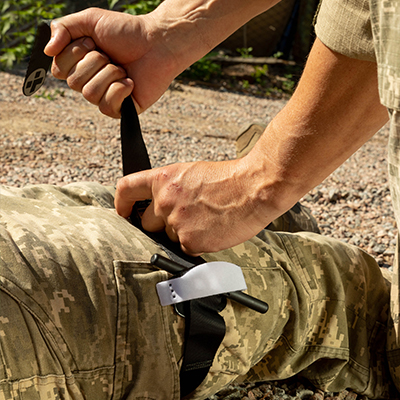Uncontrolled bleeding is the number one cause of preventable death from trauma in the United States. An adult can die from blood loss in just a few minutes if there is no intervention. If you witness someone bleeding uncontrollably – whether from a car accident, gun violence, natural disaster, or other emergency or accident – it’s important to ensure your own safety first. If you are safe, call 911 immediately or direct someone else to. Next, look for the source of bleeding. If the person’s injury is on their arm or leg, a tourniquet can potentially save their life. Found in many medical supplies or individual first aid kits (IFAK), a tourniquet is the best weapon in bleeding control and of all EMS items can be the most life-saving, especially in a severe bleeding emergency. Whereas if you’re in a medical emergency that requires the splints, you’re obviously not dealing with a bleed out or significant risk for loss of life.
What is a Tactical Tourniquet Kit?
A tourniquet is a professional or “official” device that has certain standard parts and are commonly found in medical kits in the EMS/paramedic context and in first aid. High quality medical tourniquets are used in an emergency situation to temporarily constrict and control blood flow. A tourniquet should only be used on arms and legs and looks like a strap with a buckle and a long, skinny handle. Tourniquets are typically included in most trauma kits and can also be purchased online from a medical goods store or the American Red Cross.
History of Tourniquet Use
The first reported use of a tourniquet for hemorrhage control after wounding was by a French army surgeon called Etienne Morel in 1674. The term “tourniquet” originated from the French “tourner” meaning “to turn”. Before this, tight bandages proximal to wounds were being used by surgeons as an aid to amputation as early as 1517.
Tourniquet Use On The Battlefield
They’re popular on the battlefield because they can be applied quickly and do not need to be constantly monitored once they are in place. While some military units have replaced their issue tourniquets with the SOFTT, others military units have implemented SOP’s stating that the SOF Tactical Tourniquet is to be used on all lower extremity bleeds.
The US Army and many other military groups began to include this item in their survival kits that they held with them on missions. These survival first aid kits all include many other items such as: antiseptic solutions, trauma shears, elastic bandages, quikclot, Israeli battle bandages, chest seals and plenty of other common first aid supplies inside their molle compatible, molle system combo backpacks.
Tourniquet Use In EMS Situations
North American rescue teams such as EMS, SWAT-T and Red Cross and others have emergency kits with combat action tourniquets or CAT tourniquets, built to handle hard usage in high stress situations. Before using a tourniquet, try to first stop the bleeding by applying direct pressure to the wound. If you cannot stop the bleeding with direct pressure, a tourniquet should be used. If bleeding continues after you apply the tourniquet, continue to apply pressure and tighten the strap. If the bleeding still does not stop, and a second tourniquet is available, apply the second tourniquet below the first one. Emergency responders may have questions for you when they arrive, like when you applied the tourniquet, so be sure to stay with the person until help arrives. Remember, in emergency bleeding situations, minutes matter. Applying a tourniquet on someone with a serious bleeding injury could potentially help save a life.
How To Apply A Tourniquet
- Before you apply a tourniquet, it’s important to tell the injured person that this is going to hurt.
- You can apply the tourniquet over top of bare skin and clothing.
- Place the tourniquet high and tight on the extremity (arm or leg), near the armpit or groin.
- Pull the “tail” strap of the tourniquet tight and twist the windlass until the bleeding stops. Secure the windlass to keep the tourniquet tight and in place.
- Note the time – as best you can – of when the tourniquet was applied, some tourniquets may have a white space on the strap where you can write it down.
- Do not remove the tourniquet.
Complications of Tourniquet Use
Tourniquets can arrest bleeding quite well and are certainly useful in cases of severe bleeding that cannot be stopped any other way. However, there can be complications, even when the tourniquet is used correctly. They can cause tissue damage to muscles and nerves that can take an extended time to heal. Their use can also lead to extra post-removal swelling,
Penn Care Tourniquet
Penn Care is your trusted source for tactical tourniquet kits and many other emergency medical kits used in a variety of battle and medical contexts. If you’re in the market for a tactical tourniquet kit, call Penn Care today to see what we have available in our extensive inventory. We stock some of the industry’s most trusted brands, and we’re more than happy to help guide you through your purchase!



